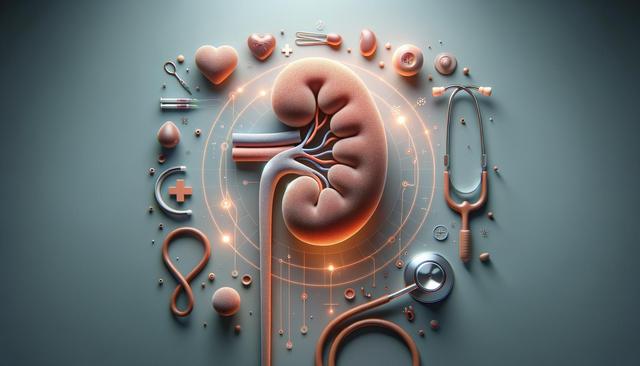Understanding Kidney Disease and Its Stages
Kidney disease, also known as chronic kidney disease (CKD), is a condition where the kidneys gradually lose their function over time. It progresses through five stages, with the final stage requiring dialysis or a kidney transplant. Each stage of CKD is associated with different symptoms and treatment needs, which is why early detection is crucial. The kidneys play a vital role in filtering waste, balancing fluids, and regulating blood pressure. When they begin to fail, these processes are disrupted, leading to serious health complications.
Common causes of CKD include:
- Diabetes
- High blood pressure
- Glomerulonephritis (inflammation of kidney filters)
- Polycystic kidney disease
Understanding the stage of kidney disease helps healthcare providers determine the appropriate treatment and lifestyle changes for each patient. Regular testing of glomerular filtration rate (GFR) and urine albumin levels are key to tracking disease progression.
Medical Treatments That Support Kidney Function
Medical therapies for kidney disease have significantly improved, offering patients more targeted and effective solutions. Depending on the stage and underlying cause, treatment may include medications to control blood pressure, blood sugar, or cholesterol levels. In recent years, new drugs have been introduced that slow the progression of CKD, especially in individuals with diabetes-related kidney damage. These medications reduce protein loss in the urine and help protect kidney function over time.
Key treatments include:
- Angiotensin-converting enzyme (ACE) inhibitors and angiotensin II receptor blockers (ARBs)
- Sodium-glucose cotransporter-2 (SGLT2) inhibitors
- Mineralocorticoid receptor antagonists (MRAs)
Along with pharmaceutical therapies, regular monitoring and timely adjustments to treatment plans are essential. Patients are also encouraged to work closely with a nephrologist to ensure that their condition is managed effectively and complications are minimized.
Dialysis as a Life-Sustaining Option
When kidney function drops below 10–15%, dialysis may be required to perform the kidneys’ filtering role. Dialysis is not a cure but a supportive therapy that helps maintain balance in the body. There are two primary types of dialysis: hemodialysis and peritoneal dialysis. Hemodialysis involves using a machine to filter the blood, while peritoneal dialysis uses the lining of the abdomen to remove waste and excess fluids.
Patients can choose between in-center dialysis and home-based options, depending on their health status, lifestyle, and support at home. Advances in dialysis technology now allow for more comfortable and flexible treatment schedules, which can improve quality of life.
Before starting dialysis, patients undergo education and training to understand:
- The differences between treatment types
- How to manage access sites
- Potential side effects and how to address them
Ongoing care and monitoring are necessary to ensure dialysis remains effective and to address any complications that may arise.
Kidney Transplant and Long-Term Management
For eligible patients, a kidney transplant can offer a longer-term solution compared to dialysis. This procedure involves replacing the damaged kidney with a healthy one from a living or deceased donor. Transplants can significantly improve life expectancy and overall well-being. However, availability of donor organs and matching criteria can limit this option for some individuals.
Post-transplant care is crucial to ensure the new kidney functions properly. Patients must take immunosuppressive medications to prevent rejection and are monitored closely for signs of infection or other complications. With proper care, transplanted kidneys can function effectively for many years.
In addition to medical management, lifestyle changes play a significant role in long-term kidney health. These include:
- Following a kidney-friendly diet
- Staying physically active
- Managing co-existing conditions like diabetes or hypertension
- Attending regular follow-up appointments
Even after a transplant, maintaining a healthy lifestyle remains critical to preserving kidney function and overall health.
Preventive Measures and Lifestyle Support
Preventing kidney disease or slowing its progression often involves proactive lifestyle choices. For individuals at risk or in early stages, small changes can have a big impact. Nutrition counseling and physical activity are cornerstones of kidney care. A diet low in sodium, phosphorus, and protein can reduce the burden on kidneys and help manage blood pressure.
Other preventive strategies include:
- Regular health screenings, especially for high-risk groups
- Avoiding non-steroidal anti-inflammatory drugs (NSAIDs) which can strain the kidneys
- Maintaining a healthy weight
- Staying adequately hydrated
Education and awareness are equally important. Patients who understand their condition are more likely to adhere to treatment plans and make informed decisions. Support groups and counseling can also help people cope with the emotional and psychological impact of living with kidney disease.
Healthcare providers often work as part of a multidisciplinary team, including dietitians, social workers, and mental health professionals, to offer comprehensive care tailored to each individual’s needs.
Conclusion: Supporting Long-Term Kidney Health
Caring for your kidneys requires a balance of medical treatment, lifestyle adjustments, and ongoing support. Advances in medication, dialysis technology, and transplant options have made it possible for individuals with kidney disease to live longer, healthier lives. Early detection and proactive management remain the most effective strategies to slow disease progression and maintain quality of life. Whether you’re managing early-stage kidney disease or facing more advanced challenges, working closely with healthcare professionals and staying informed can make a significant difference in outcomes. Prioritizing kidney health today helps ensure better health for tomorrow.




Leave a Reply